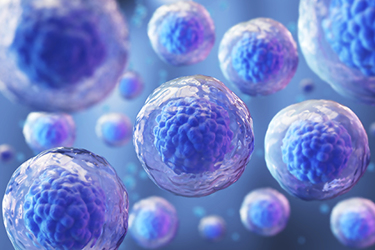Addressing The Challenges Of MSCs Will Reveal A Bright Future For This Regenerative Medicine Modality
By Dr. Ross Macdonald, Managing Director and Chief Executive Officer, Cynata Therapeutics

A record-setting amount of capital was deployed into the regenerative medicine sector in 2020 with $20 billion in investments, which is more than double the amount raised across the sector in 2019. Safety and efficacy data have started to provide a solid basis for building confidence in new and promising treatment modalities such as mesenchymal stem cells (MSCs). This particularly impacts diseases that have poor treatment options or are essentially “undruggable,” bringing long sought-after hope to patients, their caregivers, and their families. Moreover, there is growing interest from big pharma in regenerative medicine as demonstrated by increased deal flow involving small, innovative companies making substantial inroads in the development of new, advanced therapies.
As knowledge grows of the mechanisms of action of regenerative medicines regulatory agencies are becoming more comfortable with assessing regulatory applications. For example, in 2020, the FDA revealed its willingness and enthusiasm to consider MSCs as a new treatment modality with its review of the first allogeneic MSC therapy Biologics License Application (BLA). Somewhat surprisingly, the FDA decided not to approve that BLA despite receiving a positive recommendation from the Oncologic Drugs Advisory Committee (ODAC). The FDA’s concerns centered around two aspects of the BLA: clinical trial design and manufacturing process/product consistency. The extensive commentary associated with the FDA’s review provided many helpful insights for regenerative medicines companies, all of which assists ongoing engagement between sponsors and regulators.
Because MSCs are a living drug, manufacture of the finished product is exceedingly complex. The first-generation approach taken by most manufacturers to date is to rely on deriving MSCs from donors, primarily utilizing bone marrow or adipose tissue. Not only does this involve a surgical procedure (associated with some risk to the donor), but because the number of MSCs in such donations is very, very small, a combination of massive expansion in culture of the MSCs and multiple donors is required to derive even a very small number of doses. This fundamental shortcoming severely hampers the manufacturing scalability of MSC products and, whilst providing useful quantities of product for R&D purposes, poses multiple challenges in relation to product consistency. As every donor is different, so too are the MSCs derived from them. Moreover, MSCs have repeatedly been shown to undergo substantial phenotypic changes when expanded in culture, again leading to potential manufacturing inconsistency.
A More Contemporary Approach — iPSCs
These manufacturing issues apparently caused great consternation for the FDA as they go to the very heart of the cardinal requirement for consistency — and an ability to measure consistency — across finished product batches. A more contemporary approach to MSC manufacture is to use induced pluripotent stem cells (iPSCs) as the starting material. iPSCs are a unique type of stem cell that have the capacity to differentiate into nearly every tissue in the body; the process of generating them was the subject of a Nobel Prize in 2012, awarded to Professor Shinya Yamanaka and Professor John Gurdon. iPSCs are derived from a single tissue (e.g. blood) donation from a single donor, thereby ensuring a consistent starting material for finished product manufacture. As they are NOT produced from embryos, they are not subject to the considerable ethical controversy associated with use of embryonic stem cells.
The simplicity and logic of an iPSC approach has been quickly recognized as a solution to the more significant challenges of cell therapy manufacture. As such, this strategy is now being deployed by a range of cell therapy companies developing multiple different cell therapy products across indications ranging from Parkinson’s disease and cancer to respiratory distress and graft-versus-host disease. Cynata Therapeutics is pleased to have the most advanced clinical trial in this space — an ongoing Phase 3 trial of an iPSC-derived MSC product in osteoarthritis patients. This particular trial is one of the largest ever conducted with a therapeutic MSC product and is designed to address an unanswered question about the potential utility of MSCs, if this modality can not only treat the symptoms but also stop and potentially reverse the joint degeneration of this debilitating condition. We can expect to see rapid advances in this area as more companies progress their specific iPSC-derived cell therapy products.
Although the above example relating to the FDA represented a first for that agency, it is worth noting that regulators in other jurisdictions have approved MSC products and several are now in commerce in major markets. MSCs have quite rightly received much attention as a therapeutic modality in view of their potent and central role in immunomodulation and supporting regenerative processes in damaged or diseased tissues. Indeed, Professor Arnold Caplan, who first coined the term “mesenchymal stem cell” in the early 90s, has more recently recommended renaming these cells to “medicine secreting cells.”
A bright future is coming into focus for regenerative medicines, and specifically for MSCs, as the path to market for this new therapeutic modality is becoming clearer. Further safety and efficacy data from well designed and conducted clinical trials will provide a solid foundation for further applications for product marketing authorization. Meanwhile, efforts to develop new approaches to manufacturing that ensure uniformity and potency of large quantities of stem cell-based therapeutics will start to yield, thereby addressing fundamental concerns voiced by regulatory agencies about the batch-to-batch inconsistencies inherent in conventional production techniques. The ultimate outcome will be cutting-edge medicines to alleviate human suffering and increase our standards of healthcare.
